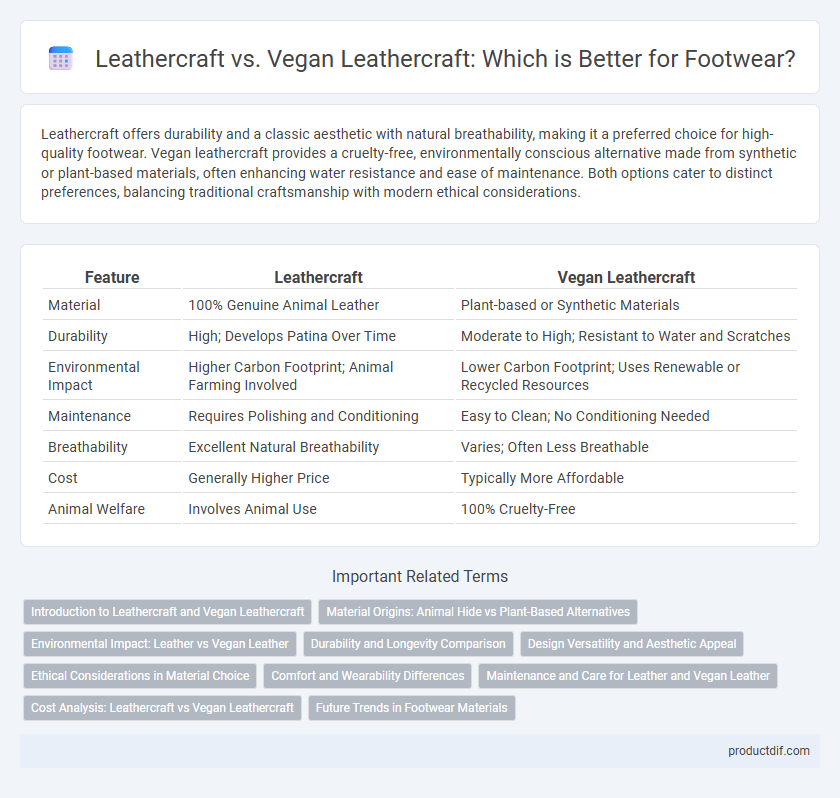Leathercraft offers durability and a classic aesthetic with natural breathability, making it a preferred choice for high-quality footwear. Vegan leathercraft provides a cruelty-free, environmentally conscious alternative made from synthetic or plant-based materials, often enhancing water resistance and ease of maintenance. Both options cater to distinct preferences, balancing traditional craftsmanship with modern ethical considerations.
Table of Comparison
| Feature | Leathercraft | Vegan Leathercraft |
|---|---|---|
| Material | 100% Genuine Animal Leather | Plant-based or Synthetic Materials |
| Durability | High; Develops Patina Over Time | Moderate to High; Resistant to Water and Scratches |
| Environmental Impact | Higher Carbon Footprint; Animal Farming Involved | Lower Carbon Footprint; Uses Renewable or Recycled Resources |
| Maintenance | Requires Polishing and Conditioning | Easy to Clean; No Conditioning Needed |
| Breathability | Excellent Natural Breathability | Varies; Often Less Breathable |
| Cost | Generally Higher Price | Typically More Affordable |
| Animal Welfare | Involves Animal Use | 100% Cruelty-Free |
Introduction to Leathercraft and Vegan Leathercraft
Leathercraft involves creating footwear using natural animal hides known for durability, breathability, and aging quality, often preferred in premium shoe manufacturing. Vegan leathercraft utilizes synthetic or plant-based materials designed to mimic leather's texture and appearance while promoting animal welfare and environmental sustainability. Both methods require specialized techniques tailored to their distinct material properties to achieve optimal comfort and style in footwear production.
Material Origins: Animal Hide vs Plant-Based Alternatives
Leathercraft utilizes animal hides derived from cattle, goats, or sheep, offering durability and natural breathability ideal for high-quality footwear. Vegan leathercraft relies on plant-based alternatives such as pineapple leaves (Pinatex), cork, apple peels, or mushroom mycelium, providing sustainable, cruelty-free options with reduced environmental impact. Material origins significantly affect the footwear's texture, longevity, and ecological footprint, making plant-based leathers increasingly popular among eco-conscious consumers.
Environmental Impact: Leather vs Vegan Leather
Leathercraft generates significant environmental impacts through deforestation, water-intensive cattle farming, and chemical-laden tanning processes that release toxins into ecosystems. Vegan leathercraft, often made from synthetic materials or plant-based alternatives like pineapple leaves and cork, reduces reliance on animal agriculture and can lower greenhouse gas emissions but sometimes involves non-biodegradable plastics and energy-intensive manufacturing. Choosing sustainable sources and circular production methods is crucial to minimizing the environmental footprint of both leather and vegan leather footwear.
Durability and Longevity Comparison
Leathercraft typically offers superior durability and longevity due to the natural toughness and ability to develop a patina over time, enhancing both strength and appearance. Vegan leathercraft, often made from synthetic materials like polyurethane or plant-based alternatives, tends to have a shorter lifespan and may wear or crack more quickly under stress. High-quality leather footwear can last decades with proper care, while vegan leather products usually require more frequent replacement due to reduced resistance to abrasion and environmental factors.
Design Versatility and Aesthetic Appeal
Leathercraft offers unmatched design versatility through its natural texture, durability, and ability to develop a rich patina over time, enhancing the aesthetic appeal of high-end footwear. Vegan leathercraft utilizes innovative synthetic materials that provide a wide range of colors, finishes, and customizable patterns, catering to modern, ethical fashion trends. The choice between these materials impacts the shoe's tactile feel, longevity, and style adaptability, with leather often preferred for classic elegance and vegan options favored for bold, contemporary designs.
Ethical Considerations in Material Choice
Leathercraft involves using animal hides, raising concerns about animal welfare and environmental impact due to livestock farming emissions and resource consumption. Vegan leathercraft offers an ethical alternative by utilizing synthetic or plant-based materials, significantly reducing harm to animals and lowering carbon footprints. Consumers increasingly prioritize sustainable practices, making ethical material choice a pivotal factor in the footwear industry.
Comfort and Wearability Differences
Leathercraft footwear offers superior breathability and molds naturally to the foot, enhancing long-term comfort and durability. Vegan leathercraft, typically made from synthetic materials like polyurethane or plant-based alternatives, provides water resistance but often lacks the same flexibility and breathability, impacting overall wearability. Consumers seeking maximum comfort and longevity often prefer genuine leather, while those prioritizing animal-friendly options may tolerate slightly reduced cushioning and moisture control in vegan alternatives.
Maintenance and Care for Leather and Vegan Leather
Leathercraft requires regular conditioning and protection with specialized leather oils and creams to maintain its suppleness and prevent cracking. Vegan leathercraft, often made from synthetic materials like polyurethane or plant-based alternatives, demands gentle cleaning with mild soap and water, avoiding harsh chemicals that can degrade the surface. Proper maintenance extends the lifespan of leather footwear, while vegan leather benefits from regular dusting and avoiding prolonged exposure to heat and direct sunlight to prevent peeling.
Cost Analysis: Leathercraft vs Vegan Leathercraft
Leathercraft typically involves higher material and production costs due to the use of genuine animal hides and labor-intensive tanning processes, resulting in a premium price for durability and quality. Vegan leathercraft, made from synthetic or plant-based materials like polyurethane or pineapple fiber, generally features lower production costs and increased scalability, making it a more affordable option for mass-market footwear. Cost analysis reveals that while leather footwear offers long-term value through longevity, vegan leather choices attract budget-conscious consumers seeking cruelty-free, cost-effective alternatives.
Future Trends in Footwear Materials
Advancements in sustainable materials are driving the footwear industry toward innovative blends of leathercraft and vegan leathercraft, with bio-based leathers gaining significant traction for their reduced environmental impact. Emerging technologies in plant-based and lab-grown materials promise enhanced durability and aesthetic quality, meeting consumer demand for ethical and eco-friendly options. These future trends indicate a shift from traditional animal hides to versatile, high-performance alternatives that balance sustainability with fashion-forward design.
Leathercraft vs Vegan Leathercraft Infographic

 productdif.com
productdif.com